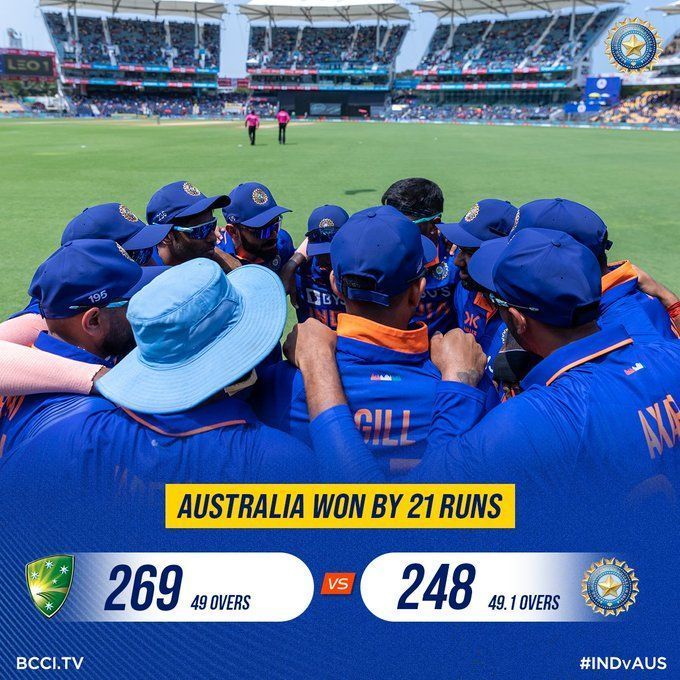
3 lessons India can learn from Australia for the 2023 World Cup
Team India succumbed to a rare series loss on home soil after Australia won the third ODI in Chennai by 21 runs. The 2-1 series result was arguably a wake-up call for the high-flying Indian side, who had won eight consecutive ODIs since December 2022.
The series loss also puts a dent in the confidence that the team had amassed in the format for quite a while. The Men in Blue easily brushed past Sri Lanka and New Zealand on home soil, ticking all the boxes on the road towards the ODI World Cup in India later this year.
However, a couple of injuries along with a change in the nature of pitches have cast some serious doubts into Team India's invincibility ahead of the marquee tournament in the October-November window.
Several take India's wins on home soil for granted, and for good reason as well, considering that they have only lost two ODI series on home soil since 2015.
However, the recent set of results against Australia have shown that things are far from perfect for Team India, and also that the Men in Yellow means absolute business.
It would be fair to say that the Men in Blue were outplayed by the visitors in the three-match series.
On that note, let us take a look at three lessons that India can learn from Australia for the 2023 ODI World Cup.
#1 Taking bold and logical decisions
Steve Smith's captaincy has been critically acclaimed following the historic series win. Apart from his tactical decisions, which included field placement and bowling changes, the stand-in skipper did not shy away from taking bold decisions.
For instance, despite David Warner returning back to the playing XI, he slotted in at the unnatural No.4 position, allowing Mitchell Marsh to continue his excellent work at the top. Apart from maintaining the left-hand-right-hand combination in the middle order, the move also allowed Australia to get an excellent start.
Anticipating that the pitch would slow down as the innings progressed and the ball got older, it was important for the Aussies to capitalize on the first powerplay. No candidate was better than Mitchell Marsh to do the task. The all-rounder scored 47 runs off 47 deliveries and was the top scorer for Australia as well.
Additionally, the decision to drop Glenn Maxwell for Ellis in the second ODI, and subsequently Nathan Ellis for Ashton Agar, worked well in favor of the team.
Smith was also bold in going for the reviews. Having blown through one review early in the innings, the stand-in skipper went upstairs in the 13th over yet again to send Shubman Gill back, which was a huge point in the run chase.
Several such small things add up together and cause a major impact. India were quite constricted in their approach and it arguably showed.
#2 Judging and assessing the conditions on offer
While it was the Australians who toured India for the series midway through the ODIs, it seemed like the other way around. Steve Smith and co. were on point while assessing the conditions, while India were lagging behind.
The teams were caught in two minds ahead of the second ODI. With the pitch being under the covers due to overnight rain, suggesting that there would be moisture and help for the seamers, history suggested that the venue would aid spinners instead.
The contrast in judging the conditions was seen right at the toss, where Smith included an extra seamer while Rohit Sharma announced the inclusion of Axar Patel as the third spinner. India then went on to suffer one of their brutal ODI losses, with all the wickets being accounted for by the seamers.
Similarly in the final ODI, Smith won the toss and elected to bat, while Rohit admitted that India were looking to field first anyway.
A similar trend was observed across both innings, where run-scoring became difficult as the innings progressed. It proved to be a touch more laborious while chasing under the lights.
This led to the impression that Smith assessed the wicket better as a visiting captain, and an area where Team India could learn from Australia.
#3 Improve on the fielding performances
Another major difference between the two sides in the recently concluded ODI series was the fielding standard.
Australia managed to maintain their usual high standards on the field. The hosts, in comparison, were easily second best, with dropped catches and misfields being a constant presence.
Additionally, it was moments of pure brilliance on the field that set Australia apart as well.
For instance, Steve Smith's ridiculous catch at first slip coupled with the run-out effort in the series finale was of the highest quality, which had a say in the result of the game as well.
Are the Men in Blue still among the favorites to lift the 2023 ODI World Cup? Let us know what you think.


